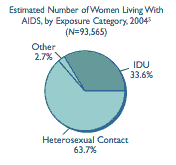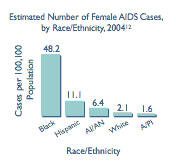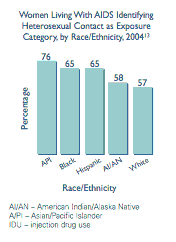Women and HIV/AIDS in the United States
Women continue to account for a growing proportion of reported U.S. AIDS cases, an extraordinarily high number of which are among racial and ethnic minorities. In addition to facing the challenges of living with HIV disease and adhering to treatment, women living with HIV often are primary caregivers for children and aging parents.
Surveillance
- Of the 42,514 estimated new AIDS cases in 2004, 26.9 percent were among women, up from 26.4 percent in 2000.1 The estimated number of AIDS diagnoses among women increased 9.9 percent from 2000 through 2004, compared with a 7.1 percent increase among men.2
- Black women accounted for the highest proportion of estimated female AIDS cases in 2004 (64.0 percent); Hispanic and White women accounted for 17.6 percent and 16.6 percent, respectively.3
- One in 4 reported AIDS cases among women are among those age 29 and younger; in contrast, 1 in 6 cases among men are in that age range.4 The difference can be explained, in part, by the fact that reproductive health needs bring young women into contact with health care providers; young women thus have more opportunities for HIV testing and detection. Sexual relationships between older men and younger women dramatically increase the risk of exposure to HIV and other sexually transmitted infections (STIs).
- Estimated AIDS mortality from 2000 to 2004 decreased by 10.3 percent for men but remained the same for women.4
- The primary exposure category for women living with AIDS in 2004 was heterosexual contact, which accounted for 63.7 percent of cases. The proportion of cases attributable to heterosexual contact increased by 52.3 percent from 2000 to 2004.5
CRITICAL ISSUES
Women with HIV/AIDS have a harder time accessing treatment and health care than men do. According to one study, however, more men (24 percent) than women (19 percent) consider HIV/AIDS the most urgent national problem.6
Minority women are particularly vulnerable to HIV infection: A study of 13,998 adolescents reported that Black adolescent girls are at greater risk (1 in 5) for STIs than White adolescent girls (1 in 10).7 Minority women in particular lack access to preventive health care services. In addition, they underestimate their risk of STIs by overestimating how safe their partners are.7,
Women with HIV/AIDS report barriers to care when seeking HIV/AIDS services. Those barriers include provider insensitivity and health care workers’ lack of knowledge.6
In addition, male-to-female transmission of HIV is between 2 and 4 times more efficient than female-to-male transmission.8 Women are especially vulnerable to HIV disease in relationships in which HIV status is not discussed and prevention methods are not incorporated. Beliefs about gender roles, knowledge of sex and sexuality, level of education, and employment all play important roles in determining risk factors and risky behavior.9
Most women who are HIV positive live in poverty and were already poor when they learned their serostatus.10,11 The socioeconomic status of women negatively influences access to health care. When women face unmet subsistence needs (e.g., for housing, food, and child care), they have little time or resources to devote to their own health. The impact on their lives and on the lives of their children—and on older adults who may be in their care—can be catastrophic.
Women and the Ryan White CARE Act
Women accounted for 31.3 percent of clients receiving services funded by the Ryan White Comprehensive AIDS Resources Emergency (CARE) Act. All CARE Act programs serve HIV-positive women, and the legislation mandates that women be served in proportion to their representation in the epidemic. In addition, the CARE Act Title IV program funds grants specifically targeting women, infants, children, youth, and families.
The Health Resources and Services Administration (HRSA) has published A Guide to the Clinical Care of Women With HIV, the first text providing comprehensive information about the clinical care of women living with HIV disease. Free copies are available at 888-ASK-HRSA.
The experience of CARE Act providers is that comprehensive and coordinated care—medical treatment, case management, support services, and care for the entire family—is crucial if HIV-positive women and their families are to remain in care over time. Comprehensive care for pregnant women has been shown to be equally critical in reducing perinatal transmission rates, which at some Title IV sites is now zero.
For more information about HIV/AIDS and women, see the December 2004 issue of HRSA CAREAction, available at www.hab.hrsa.gov/publications.
|
This document is available in pdf format:
Download PDF (76K)
  
References
1 Centers for Disease Control and Prevention (CDC). HIV/AIDS Surveillance Supplemental Report. 2002;10(1): 12. Table 3.
2 CDC. HIV/AIDS Surveillance Report. 2004;16(1):12. Table 3.
3 CDC. HIV/AIDS Surveillance Report. 2004;16(1):36. Table 21.
4 CDC. HIV/AIDS Surveillance Report. 2001;13(2):16. Table 7.
5 CDC. HIV/AIDS Surveillance Report. 2004;16(1): 20. Table 10.
6 Henry J. Kaiser Family Foundation. Survey of Americans on HIV/AIDS. Menlo Park, CA; 2004. Available at: www.kff.org/hivaids/7140.cfm.
7 Halpern CT, et al. Implications of racial and gender differences in patterns of adolescent risk behavior for HIV and other sexually transmitted diseases. Perspect Sex Reprod Health. 2004;36(6):239-47.
8 Turmen, T. Gender and HIV/AIDS. Int J Gynaecol Obstet. 2003;82:411-8.
9 Abel E, Chamber KB. Factors that
influence vulnerability to STDs and HIV/AIDS among Hispanic women. Health Care Women Int. 2004;15:761-80.
10 Siegel K, et al. Barriers and motivating factors impacting delays in seeking medical care among HIV-infected women. Paper presented at the National Conference on Women and HIV. Pasadena, CA; May 1997. Abstract 108.1.
11 Solomon L, et al. Health services use by urban women with or at risk for HIV-1 infection; the HIV Epidemiology Research Study (HERS). J Acquir Immune Defic Syndr. 1998;17: 253-61.
12 CDC. HIV/AIDS Surveillance Report. 2004;16(1):14. Table 5a.
13 CDC. HIV/AIDS Surveillance Report. 2004;16(1):21. Table 11.
|
|